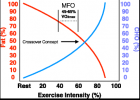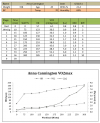We had threads, and disagreements, in the past about whether or not one needs to "enjoy" one's training. I've argued that I don't feel like I pursue training that I enjoy, but I'm realizing that what I _do_ enjoy is the pursuit of a goal, and therein lies my enjoyment, so in that way I _do_ "enjoy" my training because, even if I don't particularly like what I'm doing at the moment, I like knowing what I do will advance me towards my goal. So I will admit to, in this regard, choosing training I enjoy.
This train of thought brings me back to Aerobic Deficiency Syndrome, which I don't have because being deficient in something that doesn't matter is kind of like having a deficiency in being red-headed - I don't care if I have red hair or black hair, so yes, I'm red-haired deficient, but so what?
Item #2 on my list is health because wanting to be healthy is a well, healthy goal. If you enjoy the pursuit of what you think is healthy, and you're lacking in a measure of health, then you're deficient. But there is such a wonderfully wide range of things one can do, e.g., pursue a black belt in a martial art, that one could argue don't have specific strength or aerobic requirements, and people for centuries have pursued that kind of goal in traditional ways, i.e., practicing the art to get better at the art, without wanting or needing to either run a marathon or deadlift twice their bodyweight.
So I think it's fair to say that aerobic deficiency threshold is set much lower for one's health than it is for the pursuit of almost any athletic goal.
I also think, although I have no science to support this (but I think that science might be out there) that even someone who does nothing but minimalist strength training and does no aerobic (zone 1/2) training is likely still healthier than the general population who don't exercise for the simple reason that being stronger makes everything easier. Even if it's an aerobic activity, it'll still be easier when you're stronger.
JMO, YMMV.
-S-


